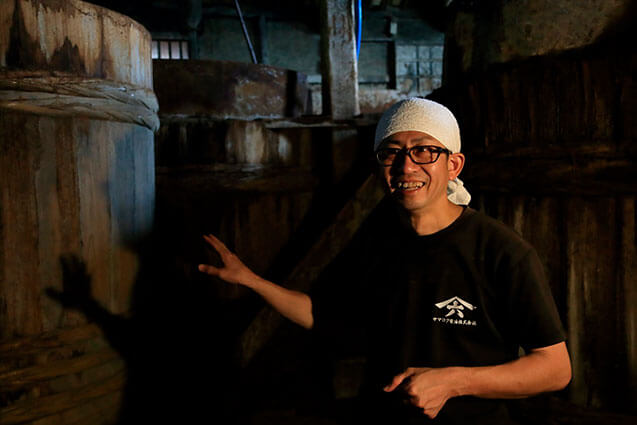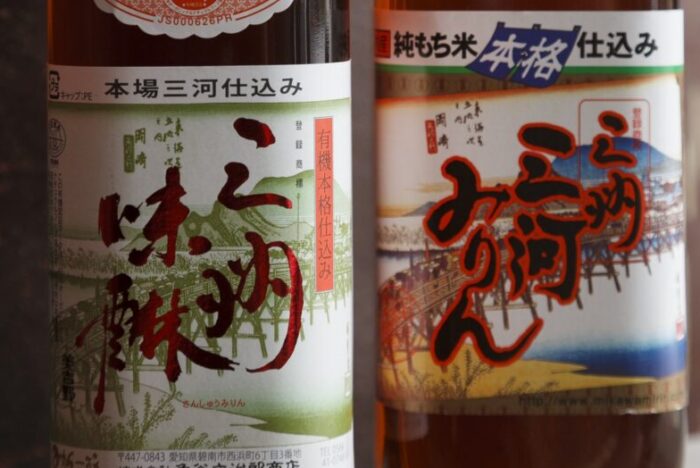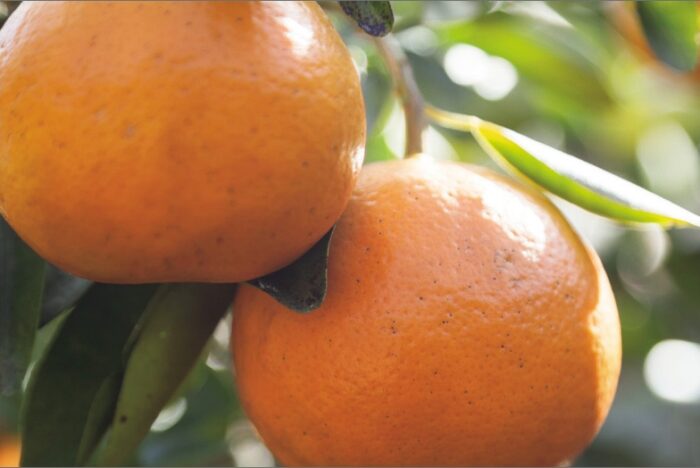Japan [Kagawa] Beyond ordinary itinerariesvol.12 Part2 Shodoshima Island in Kagawa Prefecture
Shodoshima, the Island with Various Aromas
2019.05.30

The 4th generation,Mr.Yasuhisa Fujii and the president of the 5th generation, Mrs. Sumiko Fujii.
The Aroma of Soy sauce
In the area from the stomach to the hind leg of the cow - or more precisely, the area between Kusakabe Port and Sakate Port - is called Hishio no Sato (Hometown of hishio). Hishio is a general term given to the condiments and foods made through fermentation with koji mold or salt. Here more than twenty soy sauce makers gather and the aroma of soy sauce is brought on the breeze.
According to the Japan Soy Sauce Association, there are more than a thousand shoyu (soy sauce) factories, large and small, in Japan and almost every prefecture has its own. This small island is not the exception. This small island, in fact, is one of Japan’s leading soy sauce producing areas. In the 19th century, soy sauce was made in about 400 facilities and transported by ship throughout Japan. The number of soy sauce makers, however, has decreased over time and now there are about twenty soy sauce makers are active in this area. The number has significantly changed but the production method remains the same, which is the characteristic of the soy sauce of this island.
Soy sauce is fermented and aged in a wooden bulk like Aceto Balsamico Tradizionale di Modena DOC. Less than 1% of all the soy sauce made in Japan is produced in this method. Amazingly, more than one third of this precious 1% comes from this small island! More than a thousand wooden bulks still exist in Shodoshima. There is no other option than visiting several soy sauce factories when you are in this island. Visiting several factories, not one, is the key. You will notice that every factory has its own aroma.
Kinryo Shoyu (Kinryo Say-sauce)

The 4th generation,Mr.Yasuhisa Fujii and the president of the 5th generation, Mrs. Sumiko Fujii.
Kinryo Shoyu is an interesting soy sauce maker led by the president of the fifth generation, Ms. Sumiko Fujii. Her ancestor also came to Shodoshima from Ako but they were not a salt or soy sauce maker. He was a medical doctor accompanying the salt-production engineers, and soy sauce making began much later in 1880. Kinryo Shoyu also offers a “factory” tour in a traditional wooden brewhouse, whose ceiling, ceiling joists, and the wall were blackened with fermenting yeast. The scent is different from any other brewhouses. It is the original bacteria that have been growing with the Fujii family.

Shopping in an in-house store is very interesting as you can spend hours sampling and selecting products to buy. The wide variety of products with beautiful packaging, from soy sauce to garlic flavored olive oil, is made from Ms. Fujii point of view as a woman. Kinryo Shoyu can be defined as a combination of the tradition from the past and modern lifestyle.

Kinryo Shoyu (Kinryo Say-sauce)
http://kinryo-shoyu.co.jp
842-1 Umaki Ko, Shodoshima-cho, Shozu-gun
☎ 0879-82-3333
Opening Hours: from 9:00 AM to 5:00 PM
Closing Day: Open everyday
Access: 5 min. from Kusakabe Port by car / 3 min. walk from the bus stop, Yasuda
Yamaroku Shoyu (Yamaroku Soy sauce)

Yamaroku Shoyu (Yamaroku Soy sauce) is another particular soy sauce about its traditional producing method and it has 68 wooden bulks including a 150-year-old one. “In our brewhouse more than a hundred bacteria are living. Our family has raised them for over hundreds of years and they are our own bacteria. And they and these wooden bulks have made our soy sauce - not humans! Our role is just to maintain the circumstances where good bacteria can exist in a good balance and to help the bacteria make soy sauce with watching carefully the fermentation status,” says Mr. Yasuo Yamamoto, the fifth generation of Yamaroku Shoyu. His ancestor came to Shodoshima from Ako, in the area now called Hyogo Prefecture, to bring a new technique of sea salt making during Edo Period (1603-1868).
Here, you can watch and feel the traditional method of making soy sauce. Mr. Yamamoto mixes the moromi (soy-wheat mixture with a solution of sea salt and spring water) in a large wooden bulk with a long wooden stick. He pushes the stick into the liquid. After a few seconds a bubble comes up on the surface with a sound - “sploosh”. It is like a conversation between Mr. Yamamoto and the moromi. His action is not that simple as it seems. He controls the numbers of times of his strokes, the speed and the frequency depending on the season. The aroma of moromi that also changes from time to time tells Mr. Yamamoto its own conditions!

Yamaroku Shoyu makes only two varieties of soy sauce, Tsuru-hishio and Kiku-hishio. Tsuru-hishio is double-brewed soy sauce, which means double amount of materials are needed. The salty taste comes first and richness, sweetness and umami (good taste) fills your mouth later. A mass-produced soy sauce takes only three months for production, but Tsuru-hishio takes from 4 to 5 years.
Kiku-hishio, on the other hand, is made only from black soy beans harvested in Tamba. (cf: The area near Kyoto which is famous for the production of soy beans of high quality. Its price is triple of normal soy beans harvested in Japan). This soy sauce is fermented in a bulk for two years. It has brighter color and lighter but elegant taste.

What Mr. Yamamoto makes is not only soy sauce but also wooden bulks. He was anxious about the future of soy sauce making when he saw the reality that the wooden bulk makers were vanishing in Japan. He started to create wooden bulks asking two friends of his who were the most skillful carpenters in the island to work with him, giving them just two choices for their answer- ‘yes’ or ‘oui’! “It was a past that could change the future,” says Mr. Yamamoto. As they use cedar wood for bulks and bamboo for fastening, he also cares for the material. He made good relationships with the lumbermen of cedar trees and bamboos thinking about the situation after a century from now. You may witness a mysterious traditional method of soy sauce production and the history that salvaged from the past and will be passed to the next generations here in Yamaroku Shoyu.
Yamaroku Shoyu (Yamaroku Soy sauce)
http://yama-roku.net/index.html
1607 Yasuda Ko, Shodoshima-cho, Shozu-gun
☎ 0879-82-0666
Opening Hours: from 9:00 AM to 5:00 PM
Closing Day: Open everyday
Access: 7 min. from Kusakabe Port by car / 20 min. walk from the bus stop, Yasuda
The Aroma of Soil

Lastly, the area of the ribs of the cow (the central part of the island), is a mountain top of Shodoshima. After you savor the history made by the islanders, it’s time to relish the history made by the nature. Kanka-kei (Kankakei Gorge) was selected among the 100 Landscapes of Japan in 1927 at the time of the enthronement of the emperor of Showa Era (1912). Driving up toward the mountain top is not recommend unless you are well accustomed to right-hand-driving vehicles because the roads are very steep and narrow. Instead a ropeway will take you up very easily while you see a breathtaking view of the gorge. If you are good hikers, there are two hiking trails for you. A great panoramic view of the island and the Seto Inland Sea over the gorge is a sensational way to reflect on what you saw, felt and experienced in Shodoshima!
Kankakei (Kankakei Gorge)
http://www.kankakei.co.jp/index.html
327-1 Kankakedori Otsu, Shodoshima-cho, Shozu-gun (Ropeway Station Kouun)
☎ 0879-82-0904 (Kankakei Ropeway)
Access: 15 min. from Kusakabe Port by bus (the bus stop “Kountei”)
The New Aroma of Shodoshima Invited by the Aroma of Lemon

“A lemon tree with plenty of lemons in a garden. That accelerated my decision making to relocate here,” says Mr. Nobuto Shibuya who opened an Italian restaurant “il ristorante Furyu” in 2011 on a hilltop near Kusakabe Port. He was born in Yamagata prefecture in the northern part of Japan and has experience from various restaurant kitchens in big cities. His desire was to have his own restaurant where he can make dishes with ingredients harvested or taken nearby, due to his belief that restaurants should draw upon local ingredients.
Here in Shodoshima, which is blessed with nature’s gifts from the Seto Inland Sea and uncontaminated land, he made his dream come true. The “Buy Local” movement is not just economically correct- it is also philosophically ideal as it ties body and soul to the local earth. Shibuya buys local grown vegetables and fish from the locals and also grows vegetables in his own garden. In fact, his restaurant is frequented by the locals, even if many restaurants of this category are made only for tourists in many places.

Mr. Shibuya cooks and serves by himself. His family helps him only during busy periods. The simple house with white walls is reminiscent of an agriturismo in south Italy.

Mr. Shibuya’s success has triggered snowball effect in local culinary, even though it rarely snows in Shodoshima. During the Setouchi Triennale in 2016 he opened a gelato shop called “Minori” inviting his friend, Mr. Masafumi Ichikawa, who had worked as a bartender and sommelier in Tokyo. A warehouse of rice near a bus stop in front of the ferry terminal of Kusakabe Port was renovated into a polished gelato shop and Italian styled bar.
Here exquisite ice cream made with locally harvested fruits and vegetable of the season, such as strawberry, various kinds of citrus, kiwi, plum, pumpkin, olive (of course) are served. From ten to fifteen flavors are always ready including ones rarely seen in other ice cream shops such as Sodoshima’s soy sauce, sake and roasted barley flour with Japanese brown sugar syrup. For the locals who want to taste the flavors of outside the islands, chocolate and pistachio from Italy and fruits of outside the island are not forgotten to be displayed.
The ideas of Mr. Ichikawa for ice cream are endless. Neighboring farmers bring various produce for him to make ice cream with. “It is a sheer pleasure to invent new flavors using my experience and skill as a bartender”, says Mr. Ichikawa. For him, ice cream making is same as cocktail making. The Italian restaurant “Furyu” and the ice cream shop “Minori” can be defined as a well-balanced cocktail of local and exotic cultures, which reflects the cultural diversity of Shodoshima itself.

Il ristorante Furyu
http://furyu.co/
872-2 Kusakabe-honcho, Shodoshima-cho, Shozu-gun
☎ 0879-82-2707
Opening Hours: from 11:30 to 14:30 (lunch), from 17:30 to 21:00 (dinner, only with reservation)
Closing day: Thursday, the first and the third Wednesday
Access: 5 min. walk from Kusakabe Port.

Mirori Gelato
http://minorigelato.com/
1055-2 Kusakabe-honcho, Shodoshima-cho, Shozu-gun
☎ 0879-62-8181
Opening Hours: From 10:00 AM to 7:00 PM
Closing day: Thursday, the first and the third Wednesday
Access: In front of the ferry terminal of Kusakabe Port / 1 min. walk from a bus stop “Kusakabe Port”
- 1
- 2









